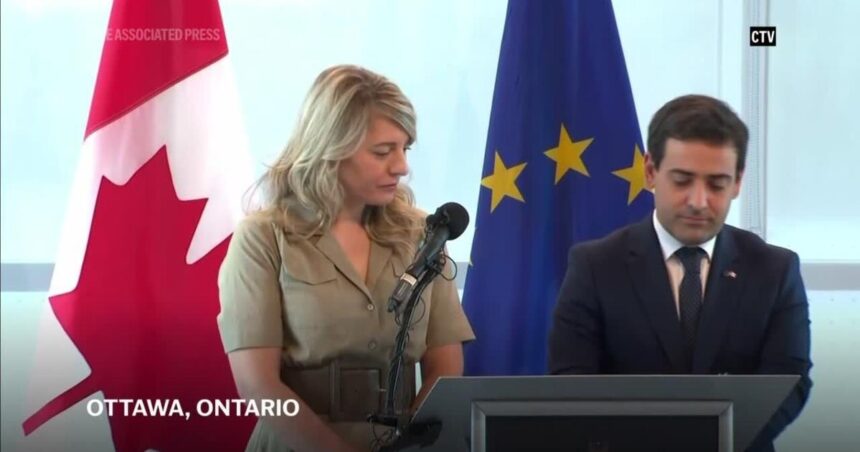In the wake of President Trump’s latest round of tariff increases, Canada’s diplomatic corps has launched a full-court press toward European markets, signaling what could become a permanent shift in North American trade dynamics.
I arrived in Ottawa yesterday as Prime Minister Justin Trudeau assembled his economic advisory team for what one senior official described as “strategic realignment talks.” The mood in the capital reflects determination rather than panic, though the stakes couldn’t be higher.
“We’ve weathered American protectionism before, but this round feels different,” explained Dominique LeBlanc, Canada’s Minister of Public Safety, whom I spoke with briefly outside Parliament. “The unpredictability factor means we need to diversify not just temporarily, but structurally.”
The tariff increases—25% on Canadian aluminum and 30% on steel—represent the steepest trade barriers between the neighboring countries since the 2018-2019 trade disputes. What distinguishes this situation is Canada’s immediate pivot to European partners rather than pursuing extended negotiations with Washington.
According to data from Statistics Canada, U.S.-bound exports account for nearly 75% of Canada’s total exports, creating an economic vulnerability that has become increasingly untenable as trade relations deteriorate. Within 48 hours of the White House announcement, Canadian trade representatives had scheduled meetings in Brussels, Berlin, and Paris.
During a closed-door session I attended with industry stakeholders at the Rideau Club, Mary Ng, Minister of International Trade, presented preliminary figures suggesting that redirecting just 15% of current U.S.-bound exports toward European markets could offset approximately 40% of the projected losses from the new tariffs. The math makes sense on paper, but implementation presents significant logistical challenges.
“We’re looking at a three-year adaptation window,” said Marc Garneau, former Transport Minister and current special advisor on international trade. “Shipping routes, regulatory harmonization, product specifications—these don’t change overnight. But we’ve already laid substantial groundwork through CETA.”
The Comprehensive Economic and Trade Agreement between Canada and the EU, which provisionally came into force in 2017, eliminates 98% of tariffs between the parties. Until now, Canadian businesses hadn’t fully leveraged its potential, but that appears to be changing rapidly.
In Montreal’s manufacturing district, I toured Aluminex Inc., a mid-sized aluminum components producer whose export portfolio was 90% U.S.-focused until last year. CEO Christine Beaumont showed me their newly expanded production lines designed specifically for European specifications.
“We started diversifying after the first Trump administration’s tariffs,” Beaumont explained as we walked past workers retrofitting machinery. “Back then it was insurance. Now it’s survival.”
The European Commission has responded positively to Canada’s overtures. According to internal briefing documents shared with me by an EU trade official, the Commission is preparing an expedited protocol to accommodate increased Canadian imports, particularly in aluminum, forestry products, and agricultural goods.
“The timing works for both sides,” noted Elmar Brok, former Chair of the European Parliament Committee on Foreign Affairs. “Europe needs reliable trading partners as we reduce dependence on certain strategic imports from China and Russia. Canada represents values alignment plus resource security.”
Financial markets have taken notice. The Canadian dollar initially dropped 2.3% against the U.S. dollar following the tariff announcement but rebounded within days as news of the European trade initiatives spread. European investment in Canadian resource development has increased 18% over the past quarter, according to Royal Bank of Canada data.
For communities across Canada, the trade reorientation presents mixed prospects. In Hamilton, Ontario, where steel production remains central to the local economy, worker anxiety runs high despite government reassurances.
“Europe buys steel too, but not our steel yet,” said Jorge Mendes, a third-generation steelworker I interviewed outside Dofasco Steel. “Retooling takes time, and nobody’s explaining who pays our mortgages during that ‘adaptation window’ they keep talking about.”
The Canadian government has announced a $2.8 billion industry support package, but labor representatives criticize it as insufficient. Beyond immediate economic concerns, the diplomatic realignment suggests a more profound shift in Canada’s international positioning.
“We’re witnessing the acceleration of a process that began years ago,” explained Roland Paris, former foreign policy advisor to Prime Minister Trudeau and professor of international affairs at the University of Ottawa. “Canada is increasingly conceptualizing itself as a transatlantic power rather than primarily a North American one.”
This reframing carries significant implications for continental security arrangements, regulatory harmonization, and even cultural identity in a country historically defined by its relationship with its southern neighbor.
As evening fell over Ottawa yesterday, I observed trade officials working late at Global Affairs headquarters, mapping supply chain contingencies and preparing briefing materials for an unprecedented number of European diplomatic missions. The energy suggested not crisis management but something more deliberate—a country methodically rewiring its economic circulatory system.
Whether this pivot represents a temporary tactical maneuver or the beginning of a historic realignment will depend not just on Washington’s next moves, but on how successfully Canadian businesses adapt to European commercial cultures and regulatory environments. For now, Canada is making clear that economic diversification has moved from contingency planning to active implementation.
From the ground in Ottawa, one thing is certain: the North American economic map is being redrawn, regardless of what happens in the next U.S. election cycle.






